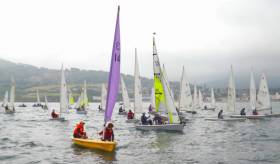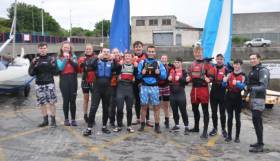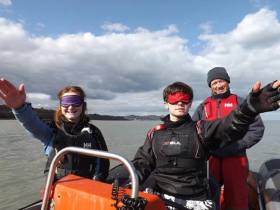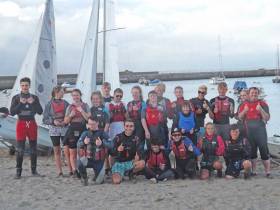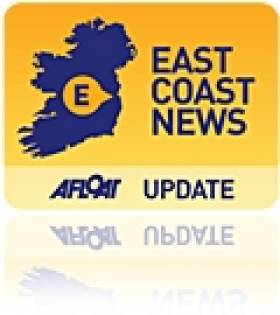Displaying items by tag: Bray Sailing Club
Bray Sailing Club’s Junior Regatta Set For Friday
#YouthSailing - Bray Sailing Club has announced details of its 2018 Junior Regatta, taking place this coming Friday 27 July.
Last year’s regatta was Bray’s largest open event, and this year the club hopes to welcome even more visitors from neighbouring clubs and make the event even bigger.
The Notice of Race, sailing instructions and entry form are now available to download from the Bray Sailing Club website.
If you are planning to bring a boat to the regatta by road, or have any other queries as a prospective competitor, contact [email protected].
Bray Sailing Club Launches Lakers at Sea Sailing Programme
Bray Sailing Club welcomed members of Lakers (a sport and recreation club for children and adults with an intellectual disability) back to the club this week to kick off the “Lakers at Sea” sailing programme. “Lakers at Sea” is a fortnightly sailing course provided by the instructors of Bray Sailing Club to build further on last year’s partnership with Lakers which started with two Try Sailing courses. The objective of the new programme is to provide Lakers members with regular sailing opportunities, where they can continue to build and develop on what they have learned.
The evening began with a shore-based briefing before heading to the beach to play a few games. Lakers members were then put through their paces as they were tasked with rigging their boats before setting sail outside the harbour. Weather conditions were extremely favourable for the evening, with light breezes allowing the novice sailors the perfect opportunity to refresh what they had learned last year and get used to being on the water again. Some of our braver sailors finished up the session with a capsize recovery drill, to prepare them for any possibilities that could lie ahead this season.
Bray SC’s Senior Instructor, Jack Hannon, commented: “We are really excited about building on the relationship we have with Lakers members by having them back down on a more permanent basis this year as part of “Lakers at Sea”. Our team of Instructors absolutely love volunteering for this and are well prepared for the season, having taken an Inclusion Sailing Training Day with Irish Sailing’s Ciaran Murphy in the off season. Hopefully this is just the start of many great evenings to come over the 2018 season with Lakers!”
Lakers at Sea will take place fortnightly in Bray Sailing Club up until early September. There are many sailing activities planned over the course of these weeks, including a cruiser sail and a “Parents on the Water” day where Lakers members will teach their parents the skills that they have learned. In addition to this, Bray SC instructors will also run two introductory “Try Sailing” courses over the summer months for new Lakers members who want to get out on the water for the first time.
Bray Sailing Club & Lakers Group Join Forces on Water
Bray Sailing Club’s instructor team for the 2018 sailing season recently spent a day learning about inclusion in sailing with Irish Sailing’s Inclusion Officer, Ciarán Murphy. This training course for the club’s instructors followed last year’s “Try Sailing” courses run by Bray Sailing Club for Lakers members, during which fourteen Lakers members took to the water for the first time.
The inclusion training was an overwhelming success, with the team of instructors learning the theoretical background to Inclusion Sailing in the morning before putting it all into practice on the water in the afternoon. The instructor team experienced what it is like to sail blind, deaf, and by using hand signals, with the use of a blindfold, ear muffs and duct tape respectively. Instructors were also instructed on the correct way to transfer people from shore to boat.
At the conclusion of the course, Bray Sailing Club’s Senior Instructor, Jack Hannon, commented “It has been a great day of fun filled learning, and we really appreciate Ciarán coming out to run the course with us. We have learned a lot which will stand to us going forward this season as we introduce a regular sailing schedule with Lakers members. This just highlights that sailing really is a sport for all and a sport for life!”
Lakers is a local social and recreation club for children and adults with an intellectual disability. As Afloat.ie previously reported, following the introductory sessions of 2017, which included the issue of the first Irish Sailing certificate in Braille, Bray Sailing Club is planning a regular sailing programme for Lakers members in 2018.
Bray Sailing Club Strengthens Ties With Lakers
Bray Sailing Club members in County Wicklow were delighted to welcome members of Lakers (a sport and recreation club for children and adults with an intellectual disability) to the club again this week to build further on the partnership which started earlier this summer. This was the second group of Lakers members to attend a “Try Sailing” course put together by Bray Sailing Club’s instructor team in 2017.
Weather conditions were extremely favourable for the course, which took place over three afternoons, and followed the same structure as before - a land-based familiarisation session on the first day, with a chance to take to the water on the following two afternoons (both inside and outside the harbour). The course concluded with a BBQ in Bray SC’s clubhouse and the presentation of Irish Sailing “Taste of Sailing” certificates to all participants by Bray SC’s Senior Instructor, Jack Hannon.
Speaking after the event, Lakers’ Services Manager, Anthony Finnegan said “We were delighted to be able to give a second group of Lakers members the opportunity to try out a new sport this week and our members are very grateful to the enthusiastic instructors and assistants, in Bray SC for giving up their time. They are just amazing and caring young people with plenty of experience to share. We hope that some of our members might have the opportunity to participate in sailing on a regular basis in the future and we look forward to a continuing relationship between Lakers and Bray SC.”
Bray SC’s Senior Instructor, Jack Hannon, commented: “I’m grateful to our team of thirteen instructors and assistants who gave up their time so willingly yet again to make this partnership a success. We now look forward to building on the success of these introductory courses and developing a more permanent connection with Lakers, and we’d like to develop a mentoring partnership between Lakers members and Bray SC members.”
Bray Lakers Take To The Sea In ‘Try Sailing’ Initiative
#TrySailing - Bray Sailing Club partnered last week with Lakers, a sport and recreation club for children and adults with an intellectual disability, to offer an introductory ‘Try Sailing’ course to seven Lakers members.
The sailability programme took place over three evenings, starting with a land-based familiarisation session on the first day, during which the newcomers to sailing learned how to rig and sit in a dinghy.
On the second evening, the group took to the water and experienced their first taste of the thrill of sailing inside the confines of Bray Harbour while the cruiser fleet raced with 25+ knots of wind outside. This session was followed by capsize drills near the beach in the harbour.
On the third evening, the dinghy fleet left the harbour and the trainees had a chance to helm their own boat, before heading into the clubhouse for a barbecue and the presentation of Irish Sailing’s Taste of Sailing certificates, including Irish Sailing’s first ever braille sailing certificate.
Speaking after the event, Lakers services manager Anthony Finnegan said: “We really appreciate the contribution of the amazing instructors and assistants in Bray SC in giving our members the opportunity to try sailing for the first time.
“The enthusiasm and excitement evident around the harbour was great to see, and we hope that some of our members will have the opportunity to participate in sailing on a regular basis in the future.”
Bray SC senior instructor Jack Hannon added: “I’m grateful to our team of instructors and assistants who gave of their time so willingly to make this partnership such a success.
“Sailing really is a sport for all, and our members were delighted to have the opportunity to share their passion for sailing with seven newcomers to the sport this week.”
Bray Sailing Club Junior Regatta Gets a Big Turnout
Bray Sailing Club took another big step forward this week in their efforts to regenerate junior dinghy sailing in the North Wicklow club with their largest Junior Regatta fleet in many years. Strongly supported by their neighbours in Greystones SC, who sailed north with a fleet of 13 boats, the 43 boats and over 70 junior sailors enjoyed four races over approximately four hours of racing in a steady force 3 south-easterly breeze.
As with most junior regattas, the three fleets encompassed a wide range of abilities, ranging from complete newcomers to sailing to the old hands trying to bag one last victory in their final Junior event. However, what was not in short supply was enthusiasm and competiveness, as evidenced by two general recalls, and a number of individual recalls.
The courses comprised a mixture of windward-leeward and triangles, with different configurations for each race to keep the youngsters on their toes. Results are available to here.
Bray Sailing Club is running a nine week junior training programme this year and has a number of exciting initiatives in the pipeline to make sailing more accessible to members of their local community, including plans for an Irish language sailing course in early 2018. Despite the difficulties caused by the recent silting in Bray Harbour, the club has experienced a significant increase in adult membership in the last few years, many of whom are parents following their children into sailing.
Bray SC Getting Young Sailors Afloat With Pico Club
#YOUTH SAILING - Bray Sailing Club has launched a new initiative to get young people out on the water this summer.
As the Sunday Independent reports, the Pico Club is named for the easy-to-sail Laser Pico dinghy that's just the vessel for young novices to get to grips with the basics of sailing.
The new club is open to all aged from eight to 18 and meets every Saturday for activities on the coast between Bray and Dun Laoghaire, such as picnics on Dalkey Island.
Taster sessions are free, with full membership (which includes a year's membership of Bray Sailing Club proper) priced at €96. For more details contact [email protected] or visit www.braysailingclub.ie.


























